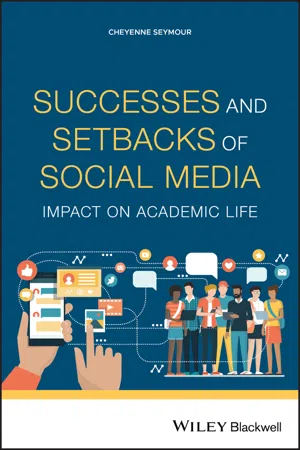
Successes and Setbacks of Social Media
Impact on Academic Life
- English
- ePUB (mobile friendly)
- Available on iOS & Android
About This Book
Discover the real-life impacts of social media use through a collection of fascinating academic perspectives
Successes and Setbacks of Social Media: Impact on Academic Life rigorously explores the positive and negative impacts of social media as a communication tool. The book incorporates a diverse group of opinions and perspectives, all of which reflect on how social media might influence academic success, relationships, self-worth, and engagement with virtual networks.
Accomplished academic and editor Dr. Cheyenne Seymour delivers an insightful examination of the different ways that social media can catapult people into success or failure. Four key areas are explored: academics, authenticity, relationships, and self-worth. Each area contains a synthesis of the latest research, supplemented with contributions that explore the negative and positive aspects of each area. The editor also includes perspectives that discuss emerging technologies, the impact they have on social media, and the impacts they might have in the future.
The book offers readers a wide variety of benefits, including:
- An informative synthesis of peer-reviewed research about the impact of social media on individuals today
- Chapters that investigate both positive and negative aspects of social media across multiple demographics and usage scenarios
- Illuminating reports on experiences with several social media platforms, including Facebook, Instagram, and Snapchat
- An analysis of potential future developments and emerging technologies in social media and the coming social and ethical concerns that might arise
Perfect for advanced undergraduate and graduate level students across a variety of disciplines, but particularly in courses on social media, mass communication, relational communication, and strategic communication, Successes and Setbacks of Social Media also belongs on the bookshelves of anyone with even a passing interest in the real-world impacts of social media usage.
Frequently asked questions
Information
Part I
Academics
1
Grades: Smiling Face Emoji
Introduction
Social Media and Student Engagement
Sharing Videos, Sharing Knowledge
Social Media Groups and Good Grades
References
- Al-Samarraie, H. (2019). A scoping review of videoconferencing systems in higher education: Learning paradigms, opportunities, and challenges. International Review of Research in Open and Distributed Learning 20 (3): 121–140. https://doi.org/10.19173/irrodl.v20i4.4037.
- Berk, R.A. (2009). Multimedia teaching with video clips: TV, movies, YouTube, and mtvU in the college classroom. International Journal of Technology in Teaching and Learning 5 (1): 1–21.
- Bowman, N.D., and Akcaoglu, M. (2014). “I see smart people!”: Using Facebook to supplement cognitive and affective learning in the university mass lecture. The Internet and Higher Education 23: 1–8. https://doi.org/10.1016/j.iheduc.2014.05.003.
- Fleck, B.K.B., Beckman, L.M., Sterns, J.L. et al. (2014). YouTube in the classroom: Helpful tips and student perceptions. Journal of Effective Teaching 14 (3): 21–37.
- Grandoni, D. (2013). First YouTube video, “Me At The Zoo,” was uploaded eight years ago, an April 23. HuffPost (23 April).
- Gregory, P., Gregory, K., and Eddy, E. (2014). The instructional network: Using Facebook to enhance undergraduate mathematics instruction. Journal of Computers in Mathematics and Science Teaching 33 (1): 5–26.
- Hurt, N.E., Moss, G.S., Bradley, C.L. et al. (2012). The “Facebook” effect: College students’ perceptions of online discussions in the age of social networking. International Journal for the Scholarship of Teaching and Learning 6 (2): 1–26.
- Junco, R., Elavsky, C.M., and Heiberger, G. (2013). Putting Twitter to the test: Assessing outcomes for student collaboration, engagement and success. British Journal of Educational Technology 44 (2): 273–287. https://doi.org/10.1111/j.1467–8535.2012.01284.x.
- Kassens, A.L. (2014). Tweeting your way to improved #writing, #reflection, and #community. The Journal of Economic Education 45 (2): 101–109. https://doi.org/10.1080/00220485.2014.889937.
- Khan Academy. (2020). A personalized learning resource for all ages. About (9 June).
- Lage, M.J., Platt, G.J., and Treglia, M. (2000). Inverting the classroom: A gateway to creating an inclusive learning environment. Journal of Economic Education 31 (1): 30–43. https://doi.org/10.2307/1183338.
- Malouff, J.M., and Emmerton, A.J. (2014). Studen...
Table of contents
- Cover
- Title page
- Copyright page
- Table of Contents
- List of Contributors
- Biography
- Introduction: Pervasiveness of Social Media in Higher Education
- Part I: Academics
- Part II Authenticity and Facades
- Part III: Relationships
- Part IV: Self-Esteem
- Part V: Looking Ahead
- Social Media Influencing Higher Education
- Index
- End User License Agreement